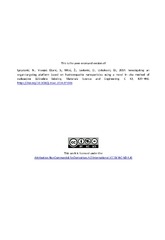Приказ основних података о документу
Investigating an organ-targeting platform based on hydroxyapatite nanoparticles using a novel in situ method of radioactive (125)Iodine labeling
| dc.creator | Ignjatović, Nenad L. | |
| dc.creator | Vranješ-Đurić, Sanja | |
| dc.creator | Mitić, Žarko | |
| dc.creator | Janković, Drina | |
| dc.creator | Uskoković, Dragan | |
| dc.date.accessioned | 2020-05-12T12:43:21Z | |
| dc.date.available | 2020-05-12T12:43:21Z | |
| dc.date.issued | 2014 | |
| dc.identifier.issn | 0928-4931 | |
| dc.identifier.uri | https://vinar.vin.bg.ac.rs/handle/123456789/8602 | |
| dc.description.abstract | In this study, we have investigated the synthesis of nanoparticles of hydroxyapatite (HAp) and hydroxyapatite coated with chitosan (HAp/Ch) and the chitosan-poly-D,L-lactide-co-glycolide polymer blend (HAp/Ch-PLGA) as an organ-targeting system. We have examined and defined the final destination, as well as the dynamics and the pathways of the synthesized particles following intravenous administration in vivo. The XRD, ZP, FT-IR and SEM analyses have confirmed that the hydroxyapatite nanoparticles with d(50) = 72 nm are coated with polymers. Radioactive 125-Iodine (I-125), a low energy gamma emitter, was used to develop a novel in situ method for the radiolabeling of particles and investigation of their biodistribution. I-125-labeled particles exhibited high stability in saline and serum over the second day, which justified their use in the following in vivo studies. The biodistribution of I-125-labeled particles after intravenous injection in rats differed significantly: HAp particles mostly targeted the liver, HAp/Ch the spleen and the liver, while HAp/Ch-PLGA targeted the lungs. Twenty-four hours post injection, HAp particles were excreted completely, while both I-125-HAp/Ch and I-125-HAp/Ch-PLGA were retained in the body for a prolonged period of time with more than 20% of radioactivity still found in different organs. (C) 2014 Elsevier B.V. All rights reserved. | en |
| dc.relation | info:eu-repo/grantAgreement/MESTD/Integrated and Interdisciplinary Research (IIR or III)/45004/RS// | |
| dc.rights | embargoedAccess | |
| dc.rights.uri | https://creativecommons.org/licenses/by-nc-nd/4.0/ | |
| dc.source | Materials Science and Engineering. C: Materials for Biological Applications | en |
| dc.subject | Nano-hydroxyapatite | en |
| dc.subject | Chitosan | en |
| dc.subject | Organ-targeting | en |
| dc.subject | In situ I-125-labeling | en |
| dc.subject | Biodistribution | en |
| dc.title | Investigating an organ-targeting platform based on hydroxyapatite nanoparticles using a novel in situ method of radioactive (125)Iodine labeling | en |
| dc.type | article | en |
| dc.rights.license | BY-NC-ND | |
| dcterms.abstract | Јанковић, Дрина; Врањеш-Ђурић, Сања; Митиц, Зарко; Ускоковић, Драган; Игњатовић, Ненад Л.; | |
| dc.citation.volume | 43 | |
| dc.citation.spage | 439 | |
| dc.citation.epage | 446 | |
| dc.identifier.wos | 000342529000054 | |
| dc.identifier.doi | 10.1016/j.msec.2014.07.046 | |
| dc.citation.rank | M23 | |
| dc.identifier.pmid | 25175234 | |
| dc.description.other | This is the peer-reviewed version of the article: Ignjatović, N., Vranješ Djurić, S., Mitić, Ž., Janković, D., Uskoković, D. 2014, "Investigating an organ-targeting platform based on hydroxyapatite nanoparticles using a novel in situ method of radioactive 125Iodine labeling", Materials Science and Engineering: C, vol. 43, pp. 439 - 446 [http://dx.doi.org/10.1016/j.msec.2014.07.046] | |
| dc.description.other | Published version: [https://vinar.vin.bg.ac.rs/handle/123456789/139] | |
| dc.type.version | acceptedVersion | |
| dc.identifier.scopus | 2-s2.0-84905381787 | |
| dc.identifier.fulltext | https://vinar.vin.bg.ac.rs/bitstream/id/21220/534.pdf |
Документи
Овај документ се појављује у следећим колекцијама
-
Radovi istraživača
Researchers' publications

